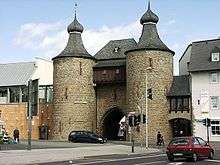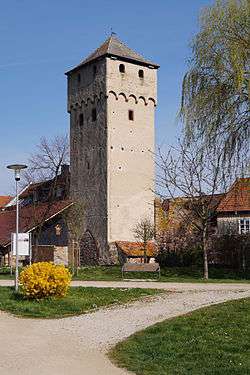Witch tower


Witch tower or Witches' Tower (German: Hexenturm) is a common name or description in English and other European languages for a tower that was part of a medieval town wall or castle, often used as a prison or dungeon.
History
The name is derived from the period of witch trials. Many of these towers were then actually used to incarcerate those suspected or found guilty of witchcraft.
Other witch towers were, however, named later, for example in the 19th century when they were simply used as normal prisons or were just ordinary towers in the city walls.
Witch towers are found in many German towns and cities such as Aschersleben, Coburg, Frankenberg (Eder), Fulda, Gelnhausen, Geseke, Heidelberg, Herborn, Hofheim am Taunus, Idstein, Jülich, Kaufbeuren, Lahnstein, Landsberg am Lech, Marburg, Markdorf, Memmingen, Olpe, Rheinbach, Rüthen, Treysa, Windecken. Today these towers are sometimes renovated and used to house museums.
According to legend, witches were actually burnt at the stake at the Witches' Tower at the Wildensteiner Burg. With trials from the region of the Upper Danube valley may be seen in the archives.
In Babenhausen, a special beer, the Hexe ("Witch") is brewed which depicts on its label the local witch tower.
In Salzburg there is a witch tower in the city walls dating to the 15th century that was used as a prison and, later, as a store. In 1944 it was destroyed by a bomb and the ruins were torn down. Only a picture on the facade of Wolf Dietrich Straße and Paris Lodron Straße recalls this building.
Surviving witch towers
- Großes Bollwerk and Hexenturm (Büdingen)
- Hexenturm (Burg)
- Hexenturm (Calbe)
- Hexenturm (Fulda)
- Hexenturm in the Old Gaol at Freising
- Hexenturm (Gelnhausen)
- Hexenturm (Herborn)
- Hexenturm (Idstein), part of Idstein Castle
- Hexenturm Jülich
- Hexenturm (Memmingen)
- Hexenturm (Oberderdingen)
- Hexenturm (Rüthen)
- Hexenturm (Sarnen)
- Hexenturm (Stein am Rhein)
Lost witch towers
- Hexenturm (Munich), a tower in Munich's second city wall
- Hexenturm (Salzburg), tower in the former city wall, today on the corner of Paris-Lodron-Straße and Wolf-Dietrich Straße
Other buildings with the name
- Wildensteiner Burg Hexenturm
Gallery
 The Hexenturm in Idstein
The Hexenturm in Idstein Witch tower in Landsberg am Lech
Witch tower in Landsberg am Lech- The Witch Tower, surrounded today by the inner courtyard of the New University, is the only remnant of the medieval town fortifications in Heidelberg
 Witch tower in Treysa
Witch tower in Treysa Witch tower in Babenhausen (Hesse)
Witch tower in Babenhausen (Hesse)
External links
| Wikimedia Commons has media related to Witch towers. |